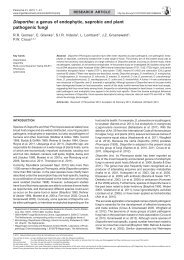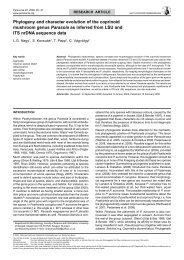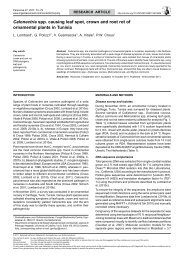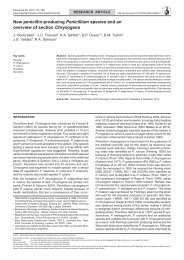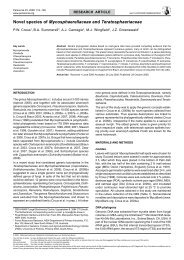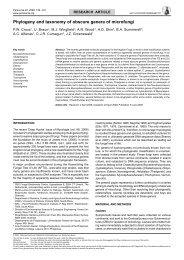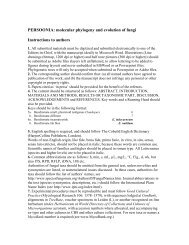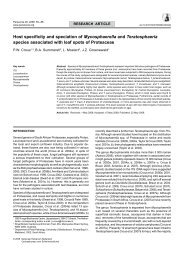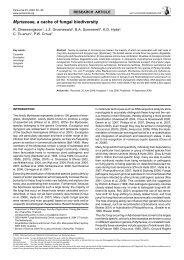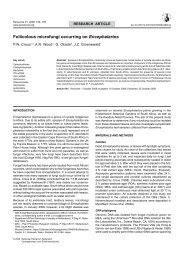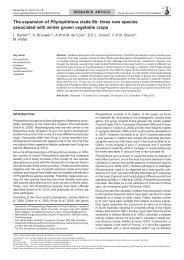Polyphasic taxonomy of the heat resistant ascomycete ... - Persoonia
Polyphasic taxonomy of the heat resistant ascomycete ... - Persoonia
Polyphasic taxonomy of the heat resistant ascomycete ... - Persoonia
You also want an ePaper? Increase the reach of your titles
YUMPU automatically turns print PDFs into web optimized ePapers that Google loves.
R.A. Samson et al.: <strong>Polyphasic</strong> <strong>taxonomy</strong> <strong>of</strong> Byssochlamys<br />
21<br />
Byssochlamys spectabilis (Udagawa & Shoji Suzuki) Houbraken<br />
& Samson, Appl. Environm. Microbiol. 74: 1618.<br />
2008. — Fig. 5<br />
Basionym. Talaromyces spectabilis Udagawa & Shoji Suzuki, Mycotaxon<br />
50: 82. 1994.<br />
Anamorph. Paecilomyces variotii Bainier, Bull. Trimestriel Soc. Mycol.<br />
France 23: 26. 1907.<br />
≡ Penicillium variotii (Bainier) Sacc., Syll. Fung. 22: 1273. 1913.<br />
Colonies spreading rapidly on MEA at 30 °C and covering <strong>the</strong><br />
Petri dish within 7 d. Similar or higher growth rate at 37 °C<br />
than at 30 °C. Good growth under microaerophilic conditions,<br />
on MEA with 0.5 % acetic acid and on CYA with 1 000 ppm<br />
propionic acid (pH 3.8). No or weak growth on CYA with 5 %<br />
NaCl (0–10 mm). Since B. spectabilis forms its ascospores in<br />
a heterothallic manner, only <strong>the</strong> anamorph is usually produced.<br />
The conidiophores are irregularly branched and ellipsoidal<br />
and/or cylindrical; truncate conidia are formed, which are <strong>of</strong>ten<br />
pale yellow brown. Chlamydospores present, smooth-walled,<br />
in some isolates finely roughened. Often broad, thick-walled<br />
hyphae are present in fresh isolates. Ascospores are formed<br />
when strains <strong>of</strong> opposite mating types are grown toge<strong>the</strong>r.<br />
Our recent study (Houbraken et al. 2008) showed that strains<br />
originating from <strong>heat</strong> treated products are mostly frequently<br />
capable <strong>of</strong> producing fertile progeny. The ascospores are ellipsoidal,<br />
smooth to finely roughened, 5.5–6.5 × 3.5–4.5 µm.<br />
Colonies on MEA agar growing rapidly, attaining a diameter <strong>of</strong><br />
7 cm within 7 d at 30 °C. Poor growth and no acid production<br />
on CREA.<br />
The extrolite viriditoxin was produced by all investigated isolates.<br />
Whe<strong>the</strong>r this extrolite is also produced in foodstuffs is<br />
unknown.<br />
Byssochlamys spectabilis commonly occurs in air, compost,<br />
infected humans and various foodstuffs (including pasteurised<br />
fruit juices, rye bread). It is frequently found in <strong>heat</strong> treated products,<br />
although after isolation only <strong>the</strong> anamorph is produced.<br />
Paecilomyces brunneolus (N. Inagaki) Samson & Houbraken,<br />
comb. nov. — MycoBank MB512559; Fig. 6g–i<br />
Basionym. Paecilomyces variotii Bainier var. brunneolus N. Inagaki, Trans.<br />
Mycol. Soc. Japan 4: 4. 1962.<br />
The type strain <strong>of</strong> P. brunneolus on MEA in 7 d forms colonies<br />
<strong>of</strong> 35–45 mm diam (30 °C) with well-defined margins. Colonies<br />
on MEA 20–30 mm diam in 7 d at 37 °C. Growth occurs<br />
under microaerophilic conditions and in <strong>the</strong> presence <strong>of</strong> 0.5 %<br />
acetic acid or 1 000 ppm propionic acid (pH 3.8). No growth<br />
is observed on CYA with 5 % NaCl. Poor growth and no acid<br />
production on CREA. Microscopical examination showed<br />
short, irregular branched conidiophores (2–3 × 15–25 µm).<br />
Conidia ellipsoidal to broadly cylindrical with truncate ends<br />
(1.5–)2–3(–3.5) × (3.5–)4–5(–5.5) µm. Chlamydospores<br />
present, smooth and hyaline.<br />
Paecilomyces brunneolus is only known from its type culture,<br />
CBS 370.70. Analyses <strong>of</strong> a part <strong>of</strong> <strong>the</strong> β-tubulin, calmodulin<br />
gene and <strong>the</strong> ITS regions showed that this strain is closely<br />
related to B. spectabilis (P. variotii). However, extrolites and<br />
morphological data support that this is a distinct species. Viriditoxin<br />
is consistently produced by B. spectabilis, while P. brunneolus<br />
produces an asc<strong>of</strong>uranone like compound and tetracyclic<br />
compounds. Paecilomyces brunneolus colonies are more<br />
restricted than strains <strong>of</strong> B. spectabilis (P. variotii) on MEA.<br />
Ano<strong>the</strong>r difference is that <strong>the</strong> growth rate <strong>of</strong> P. brunneolus at<br />
37 °C is slower than at 30 °C, while this is <strong>the</strong> opposite for<br />
B. spectabilis.<br />
This species has only been isolated from non-fat, dry milk from<br />
Canada in <strong>the</strong> 1960s.<br />
Paecilomyces divaricatus (Thom) Samson, Houbraken &<br />
Frisvad, comb. nov. — MycoBank MB512561; Fig. 6a–f<br />
Basiomym. Penicillium divaricatum Thom, Bull. Bur. Anim. Ind. U.S. Dep.<br />
Agric. 118: 92. 1910.<br />
≡ Spicaria divaricata (Thom) J.C. Gilman & E.C. Abbott, Iowa State Coll.<br />
J. Sci. 1: 301. 1929.<br />
≡ Spicaria divaricata (Thom) R.M. Ma, Lingnan Sci. J. (Suppl.) 12: 115.<br />
1933.<br />
The growth rate <strong>of</strong> P. divaricatus on MEA is restricted, compared<br />
with o<strong>the</strong>r members <strong>of</strong> <strong>the</strong> investigated Byssochlamys clade,<br />
and colonies <strong>of</strong> 30–40 mm are attained after 7 d <strong>of</strong> incubation at<br />
30 °C. Only P. brunneolus has colony diameters <strong>of</strong> comparable<br />
size. Grows at 37 °C, although slower at 30 °C. Weak growth<br />
and no acid production on CREA. Paecilomyces divaricatus is<br />
characterised by its ellipsoidal to cylindrical, truncate conidia,<br />
measuring 3.5–4.5 × 1.5–2 µm and <strong>the</strong> absence <strong>of</strong> chlamydospores.<br />
Ascomata absent on agar media, though ascomatal<br />
initials, arising as coils, can be observed. Smooth ellipsoidal<br />
ascospores were once observed in a fresh isolate (5.3–7 ×<br />
3.8–4.9 µm) but have not been seen since.<br />
Anthraquinones including emodin are produced by all investigated<br />
isolates. The production and presence <strong>of</strong> emodin, a<br />
genotoxic and diarrheagenic mycotoxin, in foods and feeds<br />
is unknown.<br />
Thom (1910) described <strong>the</strong> species Penicillium divaricatum<br />
but placed this species later in synonymy with P. variotii (Thom<br />
1930). We examined <strong>the</strong> ex-type isolate and conclude that<br />
P. divaricatus is a distinct species. Microscopical analyses <strong>of</strong><br />
<strong>the</strong> original type isolate (CBS 284.48) showed a few structures<br />
resembling ascoma initials. Using a <strong>heat</strong> treatment, strains <strong>of</strong><br />
P. divaricatus could be isolated from various food products. The<br />
survival <strong>of</strong> a <strong>heat</strong> treatment suggests <strong>the</strong> presence <strong>of</strong> a Byssochlamys<br />
teleomorph (ascospores), and many Byssochlamys<br />
initials were present (croziers) in <strong>the</strong>se strains; however, no<br />
ascomata were detected even after prolonged incubation.<br />
This species was isolated from a bottle with mucilage library<br />
paste, <strong>heat</strong> treated pectin and fruit concentrates. Its presence<br />
in <strong>heat</strong> treated products and <strong>the</strong> absence <strong>of</strong> thick-walled<br />
chlamydospores, suggests that this species is able to form <strong>heat</strong><br />
<strong>resistant</strong> ascospores.<br />
Paecilomyces formosus (Sakag., May. Inoue & Tada) Houbraken<br />
& Samson, comb. nov. — MycoBank MB512562;<br />
Fig. 7g–i<br />
Basionym. Monilia formosa Sakag., May. Inoue & Tada, Zentralbl. Bakteriol.,<br />
2. Abt. 100: 302. 1939.<br />
= Paecilomyces maximus C. Ram, Nova Hedwigia 16: 306. 1968.<br />
= Paecilomyces lecythidis C. Ram (as lecythisii), Nova Hedwigia 16: 307.<br />
1968.<br />
Fast growth on MEA at 30 °C and covering <strong>the</strong> dish within 7 d.<br />
Ratio between growth rates at 30 and 37 °C variable; most<br />
strains have slower or similar growth rates (< 1), though CBS<br />
371.70 (ex-type strain <strong>of</strong> P. maximus) and CBS 113247 are<br />
exceptions and have a faster growth rate at 37 °C. Growth on<br />
MEA with 0.5 % acetic acid varying from absence <strong>of</strong> growth to<br />
more than 80 mm after 1 wk <strong>of</strong> incubation. Variable growth patterns<br />
on CYA with 5 % NaCl, 0–25 mm. All investigated strains<br />
have poor growth on CREA and acid production under colonies.<br />
Conidiophores irregularly branched, with olive-brown conidia.<br />
Chlamydospores present (<strong>of</strong>ten on small stalks), smooth walled,<br />
globose and (weakly) pigmented. The conidia <strong>of</strong> this species<br />
are variable, varying from ellipsoidal to cylindrical; all with<br />
truncate ends. In some isolates conidial shape might vary from<br />
ellipsoidal to cylindrical.



